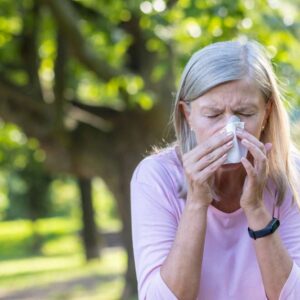
Deadly Health Danger Found in Frozen Foods
- DNA evidence has a new meaning. Find out more…
- Could a “resident”of a Washington factory be threatening your life?
- Two ways to avoid this slow-motion attack.
Dear Reader,
Buying frozen foods is a standard practice for most folks.
In fact, 99 percent of U.S. households consume frozen foods, making the frozen food industry $31 billion annually.
And while it has seen a bit of a decline in sales lately, chances are you have at least a few frozen food items in your freezer right now.
Which is exactly why you need to keep reading this.
Even though frozen foods are of endless variety, one item in particular might come to mind for you — produce.
Frozen vegetables and fruits are a convenient and often inexpensive way to add a few extra vitamins, minerals, and flavors to any meal. Plus, with frozen fruits and veggies, you don’t have to stick to what’s in season — you can eat what you want when you want it.
And you don’t have to worry about the dangers of BPA like you do with canned veggies.
However, this doesn’t mean you’re out of the danger zone.
Last week, the CDC and FDA ordered a voluntary recall of over 350 frozen produce products due to an outbreak of a deadly food-borne disease. We will share more specific brand information later on.
You might be thinking, How on Earth can bacteria survive in the freezer?
Well, prepare yourself — this microbe doesn’t die easily.
![]() An Outbreak in Slow Motion
An Outbreak in Slow Motion
Thanks to a new tracking tool, the CDC found that the current outbreak is caused by the same strain of Listeria responsible for outbreaks in 2013, 2015, and the one in February of this year. The CDC confirmed this through the bacteria’s DNA.
Meaning this outbreak has been unfolding in spurts over the last three years.
Frozen produce manufactured in Pasco, Washington, by CRF Frozen Foods is the “likely source” of this outbreak, according to the CDC.
The CDC explains a little more about Listeria:
Listeria monocytogenes is commonly found in soil and water. Animals can carry the bacterium without appearing ill and can contaminate foods of animal origin, such as meats and dairy products… When Listeria bacteria get into a food processing factory, they can live there for years, sometimes contaminating food products.2

Source: New CDC Vital Signs: Listeria Food Poisoning Striking Hard at Nation’s Most Vulnerable
The University of Georgia’s Center for Food Safety director, Michael Doyle, thinks one reason for this prolonged outbreak is “resident” Listeria. Unlike their “transient” counterparts that contaminate food as they move through the processing plant, resident bacteria are able to establish themselves in the processing plant and survive for many years.
He went on to say, “The organism’s quite hardy.”3

Magnified Listeria bacteria photo credit: study.com
So far, this hardy strain has taken the lives of two people, one in Maryland and one in Washington state, and hospitalized six others.
However, since the infection caused by Listeria (listeriosis) kills one in five victims, making it more deadly than E. coli and salmonella, it’s likely there will be more deaths and illnesses reported in the days to come.4
Older adults, pregnant women, newborns, and those with weakened immune systems are more susceptible to infection.
If you’re an older adult, your risk of infection greatly increases. In fact, anyone over 65 is four times more likely to contract illness from Listeria than the general population.
![]() Icy Precautions
Icy Precautions
The best way you can protect yourself from this outbreak is to discard any contaminated products from your freezer.
Check all items in your freezer against the FDA’s recall list. It provides detailed brand and SKU number information. If any of your items match up, you can return them for a refund or simply pitch them. Click here for the FDA recall list.
But that may not protect you from the long reach of this slow-motion outbreak.
So here’s an extra tip for added protection…
Buy a thermometer.
As we mentioned before, these bacteria can live in cold temperatures. However, experts suggest keeping your freezer at 0 F (-18 C) in order to halt Listeria growth.5
And the best news, you can purchase a commercial-grade appliance thermometer for around $6 on Amazon. Click here to check it out.
While you’re there, you might want to pick up one up for the fridge too. 40 F (4 C) or below is the optimal temperature for your fridge to halt Listeria growth on fresh foods.
If you would like some additional tips on how to reduce Listeria exposures from fresh produce, click here to read a previous article from Living Well Daily.
Live well,

Natalie Moore
Managing editor, Living Well Daily
Ed. Note: Please send your feedback: nmoore@lfb.org – and click here to like us on Facebook.
Sources
[1] Cold Facts About Frozen Foods
[2] Multistate Outbreak of Listeriosis Linked to Frozen Vegetables
[3] 4 things to remember about your frozen greens and the Listeria recall
[4] Older Americans, pregnant women face highest risk from Listeria food poisoning
[5] Special Handling for Ready-to-Eat, Refrigerated Foods
Written By Natalie Moore
Natalie Moore is a dedicated health researcher with a passion for finding healthy, natural, and science-based solutions. After a decade of direct healthcare experience in western and natural medicine, she was involved in public health research before joining Living Well Daily.
View More Free Articles
Can't Shake Negative Thoughts? Check Your GUT First
Everyone struggles sometimes to stay positive or see the bright side of things. It’s part of being human. You might think those negative thoughts start in your brain—but it’s more complicated than that. A simple change to your daily habit can help dial down those negative feelings. New research suggests that this simple strategy could...
Repair Your Gut Barrier With the “Sunshine Cure”
Happy Fourth of July! As you celebrate with sunshine, good food, and great company, don’t forget—those summer rays aren’t just lifting your spirits… they’re also working behind the scenes to protect your gut and boost your health. Your gut health is more important than most people realize. It directly affects your overall well-being—from immunity to...
The 5 Health Numbers Your Doctor Wishes You'd Track
Have you ever been told you should “advocate” for yourself when it comes to your healthcare and wondered what that really means? It’s not just a buzzword—it’s a powerful concept that empowers you to take charge of your own health journey. In fact, it could save your life. Being your own best health advocate starts...
Do THIS Every 20 Minutes to STOP Digital Eye Strain
Our eyes are under assault—they are the true victims of our current digital age. And it’s because we are constantly glued to screens… phones, tablets, computers, TVs—you name it. Unfortunately, that screen time is taking a serious toll. Digital eye strain affects millions worldwide. In fact, up to 50 percent of computer users could develop...
Mailbag: The Calcium Mistake That's Hardening Your Arteries
“What type of calcium is best to take with bisphosphonates for osteoporosis? I know some varieties can build up in arteries. Thanks for the help.” —Bone Builder Hi Builder, When a patient asks me about calcium, I ask them a peculiar question in return… “Ever wonder how elephants and giraffes build and maintain their massive...
Doctor-Approved Method to Ditch Blood Pressure Meds
In a world where drug solutions dominate healthcare, it’s refreshing to discover that best remedies sometimes don’t involve a single pill. A groundbreaking study shows simple relaxation techniques could be your secret weapon against one of America’s deadliest health conditions. Best of all? It’s free, easy to start right away—and your results are bound to...
Trouble Hearing? Your Heart Could Be at Risk
With research exploding and data pouring in, scientists are uncovering some weird (and surprisingly helpful) health connections. Today’s odd couple? Hearing loss and heart failure. Turns out your ears and your ticker are more connected than you ever imagined. A major study published in the journal Heart looked at over 164,000 people for nearly a...
Stay Up Late? It Could Destroy Your Mental Health
If you dread mornings but come alive at night, there’s concerning new research you need to know about. A recent study found that “night owls” are at higher risk for depression. But before you rush to set your alarm to get up with the sun tomorrow, there’s more to the story… Chronotypes are essentially your...
Go from Flabby to Fit with this Common Vitamin
If you’re like many of us, you woke up one day, looked in the mirror, and realized you’re no spring chicken anymore. Even worse—when you weren’t paying attention—it seems you somehow misplaced the muscles of your youth and have gone from fit to flabby. Aging has a way of humbling us like that. But scientists...
Seasonal Allergy “Off Switch” Discovered in the GUT
“Doc, why am I suddenly suffering from seasonal allergies when I’ve never had them before?” It’s a question I get all the time—and my answer might surprise you. Stop looking up at the trees—and start looking down at your gut… Your sneezing fits, itchy eyes, and runny nose might have more to do with what’s...









